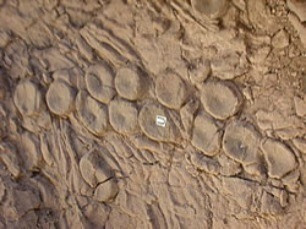Ancient Giant Sea Monster Kraken Probably Ate Ichthyosaur For Breakfast

In the world of the prehistoric oceans, the leviathan known as the ichthyosaur was thought to be king. It was an air-breathing, bus-sized monster with a long mouth full of jagged teeth. But Mount Holyoke College paleontologist Mark McMenamin believes there was an even more fearsome creature roaming the Triassic Seas: A huge kraken, or something like it.
Just like the mythical giant octopuses of old fishermen's tales, there could have been giant cephalopods killing and eating the ichthyosaurs. The theory is based on an old puzzle held in Nevada's Berlin-Ichthyosaur State Park. The park is the ancient grave of nine 45-foot ichthyosaur remains.
"Charles Camp puzzled over these fossils in the 1950s," McMenamin said, in a press release from the Geological Society of America. "In his papers he keeps referring to how peculiar this site is. We agree, it is peculiar."
The remains seemed oddly stacked in a way no research could explain. Camp, a U.C. Berkeley professor, thought the ichthyosaurs died of toxic plankton bloom, which requires shallow water. However, the most recent survey of the region suggests it was actually a deep water environment. Also the etching on the bones of the animals suggested they were not all killed and buried at the same time.
McMenamin knew something very odd was happening.
"I was aware that anytime there is controversy about depth, there is probably something interesting going on," McMenamin said.
The bones also seemed to be purposefully rearranged. This led McMenamin to the conclusion that giant kraken-like monsters swam in the same seas. Modern octopuses are known to leave piles of bones and shells in their dens. They are also been observed rearranging these remains. The octopus's reputation as a killer was solidified in a video of an octopus killing a shark at the Seattle Aquarium.
"We think that this cephalopod in the Triassic was doing the same thing," McMenamin said. "It was either drowning them or breaking their necks."
What is even more amazing is these piles of bones may be the earliest example of prehistoric self portraits. The ichthyosaurs vertebral disks were arranged in a linear fashion of double line patterns perhaps resembling the sucker discs of the krakens themselves.
"It's the perfect Triassic crime because octopuses are mostly soft-bodied and don't fossilize well," Christa Stratton said, spokesman for the GSA, since their beaks are the only hard part of their body.
That means there is no hard evidence for the theory. But McMenamin is ready to defend his theory against skeptics.
"We're ready for this," McMenamin said. "We have a very good case."
© Copyright IBTimes 2024. All rights reserved.





















